Development and Validation of Prognostic Models Using Radiomic Features from Pre-Treatment Positron Emission Tomography (PET) Images in Head and Neck Squamous Cell Carcinoma (HNSCC) Patients
Abstract
Simple Summary
Abstract
1. Introduction
2. Materials and Methods
2.1. Patient Data
2.2. Segmentation
2.3. Preprocessing
2.4. Feature Extraction
2.5. Data Preparation
2.6. Model Training and Validation
2.7. Model Performance Evaluation
3. Results
3.1. Patient Characteristics
3.2. Machine Learning-Based Prognostic Models
3.2.1. All-Cause Mortality
3.2.2. Locoregional Recurrent/Residual Disease
3.2.3. Distant Metastasis
4. Discussion
Limitations and Recommendations
5. Conclusions
Supplementary Materials
Author Contributions
Funding
Institutional Review Board Statement
Informed Consent Statement
Data Availability Statement
Conflicts of Interest
References
- Bhatia, A.; Burtness, B. Treating Head and Neck Cancer in the Age of Immunotherapy: A 2023 Update. Drugs 2023, 83, 217–248. [Google Scholar] [CrossRef] [PubMed]
- Chow, Q.M.L. Head and Neck Cancer. N. Engl. J. Med. 2020, 382, 60–72. [Google Scholar] [CrossRef]
- Gong, Y.; Bao, L.; Xu, T.; Yi, X.; Chen, J.; Wang, S.; Pan, Z.; Huang, P.; Ge, M. The Tumor Ecosystem in Head and Neck Squamous Cell Carcinoma and Advances in Ecotherapy. Mol. Cancer 2023, 22, 68. [Google Scholar] [CrossRef]
- Chaves, P.; Garrido, M.; Oliver, J.; Pérez-Ruiz, E.; Barragan, I.; Rueda-Domínguez, A. Preclinical Models in Head and Neck Squamous Cell Carcinoma. Br. J. Cancer 2023, 128, 1819–1827. [Google Scholar] [CrossRef]
- Goel, B.; Tiwari, A.K.; Pandey, R.K.; Singh, A.P.; Kumar, S.; Sinha, A.; Jain, S.K.; Khattri, A. Therapeutic Approaches for the Treatment of Head and Neck Squamous Cell Carcinoma-An Update on Clinical Trials. Transl. Oncol. 2022, 21, 101426. [Google Scholar] [CrossRef] [PubMed]
- Lambin, P.; Zindler, J.; Vanneste, B.G.L.; Van De Voorde, L.; Eekers, D.; Compter, I.; Panth, K.M.; Peerlings, J.; Larue, R.T.H.M.; Deist, T.M.; et al. Decision Support Systems for Personalized and Participative Radiation Oncology. Adv. Drug Deliv. Rev. 2017, 109, 131–153. [Google Scholar] [CrossRef] [PubMed]
- Jung, J.-O.; Crnovrsanin, N.; Wirsik, N.M.; Nienhüser, H.; Peters, L.; Popp, F.; Schulze, A.; Wagner, M.; Müller-Stich, B.P.; Büchler, M.W.; et al. Machine Learning for Optimized Individual Survival Prediction in Resectable Upper Gastrointestinal Cancer. J. Cancer Res. Clin. Oncol. 2023, 149, 1691–1702. [Google Scholar] [CrossRef]
- Kourou, K.; Exarchos, T.P.; Exarchos, K.P.; Karamouzis, M.V.; Fotiadis, D.I. Machine Learning Applications in Cancer Prognosis and Prediction. Comput. Struct. Biotechnol. J. 2015, 13, 8–17. [Google Scholar] [CrossRef]
- Huynh, B.N.; Groendahl, A.R.; Tomic, O.; Liland, K.H.; Knudtsen, I.S.; Hoebers, F.; van Elmpt, W.; Malinen, E.; Dale, E.; Futsaether, C.M. Head and Neck Cancer Treatment Outcome Prediction: A Comparison between Machine Learning with Conventional Radiomics Features and Deep Learning Radiomics. Front. Med. 2023, 10, 1217037. [Google Scholar] [CrossRef]
- Hu, C.; Steingrimsson, J.A. Personalized Risk Prediction in Clinical Oncology Research: Applications and Practical Issues Using Survival Trees and Random Forests. J. Biopharm. Stat. 2018, 28, 333–349. [Google Scholar] [CrossRef]
- Tomaszewski, M.R.; Gillies, R.J. The Biological Meaning of Radiomic Features. Radiology 2021, 298, 505–516. [Google Scholar] [CrossRef]
- Palomino-Fernández, D.; Milara, E.; Galiana, Á.; Sánchez-Ortiz, M.; Seiffert, A.P.; Jiménez-Almonacid, J.; Gómez-Grande, A.; Ruiz-Solís, S.; Ruiz-Alonso, A.; Gómez, E.J.; et al. Textural and Conventional Pretherapeutic [18F]FDG PET/CT Parameters for Survival Outcome Prediction in Stage III and IV Oropharyngeal Cancer Patients. Appl. Sci. 2024, 14, 1454. [Google Scholar] [CrossRef]
- Yao, S.; Wang, X. Statistical and Machine Learning Methods for Discovering Prognostic Biomarkers for Survival Outcomes BT. In Statistical Genomics; Fridley, B., Wang, X., Eds.; Springer: New York, NY, USA, 2023; pp. 11–21. ISBN 978-1-0716-2986-4. [Google Scholar]
- Spooner, A.; Chen, E.; Sowmya, A.; Sachdev, P.; Kochan, N.A.; Trollor, J.; Brodaty, H. A Comparison of Machine Learning Methods for Survival Analysis of High-Dimensional Clinical Data for Dementia Prediction. Sci. Rep. 2020, 10, 20410. [Google Scholar] [CrossRef] [PubMed]
- Turkson, A.J.; Ayiah-Mensah, F.; Nimoh, V. Handling Censoring and Censored Data in Survival Analysis: A Standalone Systematic Literature Review. Int. J. Math. Math. Sci. 2021, 2021, 9307475. [Google Scholar] [CrossRef]
- Philip, M.M.; Welch, A.; McKiddie, F.; Nath, M. A Systematic Review and Meta-Analysis of Predictive and Prognostic Models for Outcome Prediction Using Positron Emission Tomography Radiomics in Head and Neck Squamous Cell Carcinoma Patients. Cancer Med. 2023, 12, 16181–16194. [Google Scholar] [CrossRef]
- Kocak, B.; Baessler, B.; Bakas, S.; Cuocolo, R.; Fedorov, A.; Maier-Hein, L.; Mercaldo, N.; Müller, H.; Orlhac, F.; Pinto dos Santos, D.; et al. CheckList for EvaluAtion of Radiomics Research (CLEAR): A Step-by-Step Reporting Guideline for Authors and Reviewers Endorsed by ESR and EuSoMII. Insights Imaging 2023, 14, 75. [Google Scholar] [CrossRef]
- Vallières, M. Data from Head-Neck-PET-CT—The Cancer Imaging Archive (TCIA). Available online: https://wiki.cancerimagingarchive.net/display/Public/Head-Neck-PET-CT (accessed on 1 February 2023).
- Grossberg, A.; Elhalawani, H.; Mohamed, A.; Mulder, S.; Williams, B.; White, A.L.; Zafereo, J.; Wong, A.J.; Berends, J.E.; AboHashem, S.; et al. HNSCC—The Cancer Imaging Archive (TCIA) Public Access—Cancer Imaging Archive Wiki. Available online: https://wiki.cancerimagingarchive.net/display/Public/HNSCC (accessed on 16 October 2023).
- Vallières, M.; Kay-Rivest, E.; Perrin, L.J.; Liem, X.; Furstoss, C.; Aerts, H.J.W.L.W.L.; Khaouam, N.; Nguyen-Tan, P.F.; Wang, C.-S.S.; Sultanem, K.; et al. Radiomics Strategies for Risk Assessment of Tumour Failure in Head-and-Neck Cancer. Sci. Rep. 2017, 7, 10117. [Google Scholar] [CrossRef]
- Grossberg, A.J.; Mohamed, A.S.R.; El Halawani, H.; Bennett, W.C.; Smith, K.E.; Nolan, T.S.; Williams, B.; Chamchod, S.; Heukelom, J.; Kantor, M.E.; et al. Data Descriptor: Imaging and Clinical Data Archive for Head and Neck Squamous Cell Carcinoma Patients Treated with Radiotherapy. Sci. Data 2018, 5, 180173. [Google Scholar] [CrossRef] [PubMed]
- Cook, G.J.R.; Siddique, M.; Taylor, B.P.; Yip, C.; Chicklore, S.; Goh, V. Radiomics in PET: Principles and Applications. Clin. Transl. Imaging 2014, 2, 269–276. [Google Scholar] [CrossRef]
- Orlhac, F.; Nioche, C.; Klyuzhin, I.; Rahmim, A.; Buvat, I. Radiomics in PET Imaging: A Practical Guide for Newcomers. PET Clin. 2021, 16, 597–612. [Google Scholar] [CrossRef]
- Scikit-Learn: Machine Learning in Python—Scikit-Learn 1.2.1 Documentation. Available online: https://scikit-learn.org/stable/ (accessed on 26 January 2023).
- Pölsterl, S. Scikit-Survival: A Library for Time-to-Event Analysis Built on Top of Scikit-Learn. J. Mach. Learn. Res. 2020, 21, 1–6. [Google Scholar]
- Lo Iacono, F.; Maragna, R.; Pontone, G.; Corino, V.D.A. A Robust Radiomic-Based Machine Learning Approach to Detect Cardiac Amyloidosis Using Cardiac Computed Tomography. Front. Radiol. 2023, 3, 1193046. [Google Scholar] [CrossRef]
- Ishwaran, H.; Kogalur, U.B.; Blackstone, E.H.; Lauer, M.S. Random Survival Forests. Ann. Appl. Stat. 2008, 2, 841–860. [Google Scholar] [CrossRef]
- Pölsterl, S.; Navab, N.; Katouzian, A. An Efficient Training Algorithm for Kernel Survival Support Vector Machines. arXiv 2016, arXiv:1611.07054. [Google Scholar]
- Hothorn, T.; Bühlmann, P.; Dudoit, S.; Molinaro, A.; Van Der Laan, M.J. Survival Ensembles. Biostatistics 2005, 7, 355–373. [Google Scholar] [CrossRef]
- Simon, N.; Friedman, J.; Hastie, T.; Tibshirani, R. Regularization Paths for Cox’s Proportional Hazards Model via Coordinate Descent. J. Stat. Softw. 2011, 39, 1–13. [Google Scholar] [CrossRef]
- 4.2. Permutation Feature Importance—Scikit-Learn 1.4.1 Documentation. Available online: https://scikit-learn.org/stable/modules/permutation_importance.html (accessed on 29 February 2024).
- Adeoye, J.; Hui, L.; Koohi-moghadam, M.; Yan, J.; Choi, S.; Thomson, P. Comparison of Time-to-Event Machine Learning Models in Predicting Oral Cavity Cancer Prognosis. Int. J. Med. Inform. 2022, 157, 104635. [Google Scholar] [CrossRef]
- Evaluating Survival Models—Scikit-Survival 0.22.2. Available online: https://scikit-survival.readthedocs.io/en/stable/user_guide/evaluating-survival-models.html (accessed on 23 February 2024).
- Pisani, P.; Airoldi, M.; Allais, A.; Aluffi Valletti, P.; Battista, M.; Benazzo, M.; Briatore, R.; Cacciola, S.; Cocuzza, S.; Colombo, A.; et al. Metastatic Disease in Head & Neck Oncology. Acta Otorhinolaryngol. Ital. 2020, 40, S1–S86. [Google Scholar]
- Pineiro-Fiel, M.; Moscoso, A.; Pubul, V.; Ruibal, A.; Silva-Rodriguez, J.; Aguiar, P.; Piñeiro-Fiel, M.; Moscoso, A.; Pubul, V.; Ruibal, Á.; et al. A Systematic Review of PET Textural Analysis and Radiomics in Cancer. Diagnostics 2021, 11, 380. [Google Scholar] [CrossRef] [PubMed]
- Avanzo, M.; Wei, L.; Stancanello, J.; Vallières, M.; Rao, A.; Morin, O.; Mattonen, S.A.; El Naqa, I. Machine and Deep Learning Methods for Radiomics. Med. Phys. 2020, 47, e185. [Google Scholar] [CrossRef] [PubMed]
- Amadasun, M.; King, R. Texural Features Corresponding to Texural Properties. IEEE Trans. Syst. Man. Cybern. 1989, 19, 1264–1274. [Google Scholar] [CrossRef]
- Cook, G.J.R.; Yip, C.; Siddique, M.; Goh, V.; Chicklore, S.; Roy, A.; Marsden, P.; Ahmad, S.; Landau, D. Are Pretreatment 18F-FDG PET Tumor Textural Features in Non-Small Cell Lung Cancer Associated with Response and Survival After Chemoradiotherapy? J. Nucl. Med. 2013, 54, 107375. [Google Scholar] [CrossRef]
- Noortman, W.A.; Aide, N.; Vriens, D.; Arkes, L.S.; Slump, C.H.; Boellaard, R.; Goeman, J.J.; Deroose, C.M.; Machiels, J.-P.; Licitra, L.F.; et al. Development and External Validation of a PET Radiomic Model for Prognostication of Head and Neck Cancer. Cancers 2023, 15, 2681. [Google Scholar] [CrossRef]
- Ambler, G.; Seaman, S.; Omar, R.Z. An Evaluation of Penalised Survival Methods for Developing Prognostic Models with Rare Events. Stat. Med. 2012, 31, 1150–1161. [Google Scholar] [CrossRef]
- Niyoteka, S.; Seban, R.-D.; Rouhi, R.; Scarsbrook, A.; Genestie, C.; Classe, M.; Carré, A.; Sun, R.; La Greca Saint-Esteven, A.; Chargari, C.; et al. A Common [18F]-FDG PET Radiomic Signature to Predict Survival in Patients with HPV-Induced Cancers. Eur. J. Nucl. Med. Mol. Imaging 2023, 50, 4010–4023. [Google Scholar] [CrossRef]
- Wang, Y.; Deng, Y.; Tan, Y.; Zhou, M.; Jiang, Y.; Liu, B. A Comparison of Random Survival Forest and Cox Regression for Prediction of Mortality in Patients with Hemorrhagic Stroke. BMC Med. Inform. Decis. Mak. 2023, 23, 215. [Google Scholar] [CrossRef]
- Wang, H.; Li, G. A Selective Review on Random Survival Forests for High Dimensional Data. Quant. Bio-Sci. 2017, 36, 85–96. [Google Scholar] [CrossRef]
- Chen, H.C.; Kodell, R.L.; Cheng, K.F.; Chen, J.J. Assessment of Performance of Survival Prediction Models for Cancer Prognosis. BMC Med. Res. Methodol. 2012, 12, 102. [Google Scholar] [CrossRef]
- Haider, H.; Hoehn, B.; Davis, S.; Greiner, R. Effective Ways to Build and Evaluate Individual Survival Distributions. J. Mach. Learn. Res. 2020, 21, 3289–3351. [Google Scholar]
- Romesser, P.B.; Lim, R.; Spratt, D.E.; Setton, J.; Riaz, N.; Lok, B.; Rao, S.; Sherman, E.J.; Schöder, H.; Lee, N.Y. The Relative Prognostic Utility of Standardized Uptake Value, Gross Tumor Volume, and Metabolic Tumor Volume in Oropharyngeal Cancer Patients Treated with Platinum Based Concurrent Chemoradiation with a Pre-Treatment [(18)F] Fluorodeoxyglucose Positron Em. Oral Oncol. 2014, 50, 802–808. [Google Scholar] [CrossRef]
- Sundrani, S.; Lu, J. Computing the Hazard Ratios Associated With Explanatory Variables Using Machine Learning Models of Survival Data. JCO Clin. Cancer Inform. 2021, 5, 364–378. [Google Scholar] [CrossRef]
- Rajput, D.; Wang, W.-J.; Chen, C.-C. Evaluation of a Decided Sample Size in Machine Learning Applications. BMC Bioinform. 2023, 24, 48. [Google Scholar] [CrossRef]
- Ribeiro, I.P.; Esteves, L.; Caramelo, F.; Carreira, I.M.; Melo, J.B. Integrated Multi-Omics Signature Predicts Survival in Head and Neck Cancer. Cells 2022, 11, 2536. [Google Scholar] [CrossRef]
- Marcu, L.G.; Marcu, D.C. Current Omics Trends in Personalised Head and Neck Cancer Chemoradiotherapy. J. Pers. Med. 2021, 11, 1094. [Google Scholar] [CrossRef]
- Wu, H.; Liu, X.; Peng, L.; Yang, Y.; Zhou, Z.; Du, D.; Xu, H.; Lv, W.; Lu, L. Optimal Batch Determination for Improved Harmonization and Prognostication of Multi-Center PET/CT Radiomics Feature in Head and Neck Cancer. Phys. Med. Biol. 2023, 68, 22. [Google Scholar] [CrossRef]
- Xu, H.; Abdallah, N.; Marion, J.-M.; Chauvet, P.; Tauber, C.; Carlier, T.; Lu, L.; Hatt, M. Radiomics Prognostic Analysis of PET/CT Images in a Multicenter Head and Neck Cancer Cohort: Investigating ComBat Strategies, Sub-Volume Characterization, and Automatic Segmentation. Eur. J. Nucl. Med. Mol. Imaging 2023, 50, 1720–1734. [Google Scholar] [CrossRef]
- Philip, M.M.; Watts, J.; Niki, S.; Moeini, M.; Musheb, M.; Mckiddie, F. Comparison of Semi-Automatic and Manual Segmentation Methods for Tumor Delineation on Head and Neck Squamous Cell Carcinoma (HNSCC) Positron Emission Tomography (PET) Images Comparison of Semi-Automatic and Manual Segmentation Methods for Tumor Deline. Phys. Med. Biol. 2024, 69, 9. [Google Scholar] [CrossRef]
- Wiegrebe, S.; Kopper, P.; Sonabend, R.; Bischl, B.; Bender, A. Deep Learning for Survival Analysis: A Review. Artif. Intell. Rev. 2024, 57, 65. [Google Scholar] [CrossRef]
- Wang, P.; Li, Y.; Reddy, C.K. Machine Learning for Survival Analysis: A Survey. ACM Comput. Surv. 2019, 51, 1–36. [Google Scholar] [CrossRef]
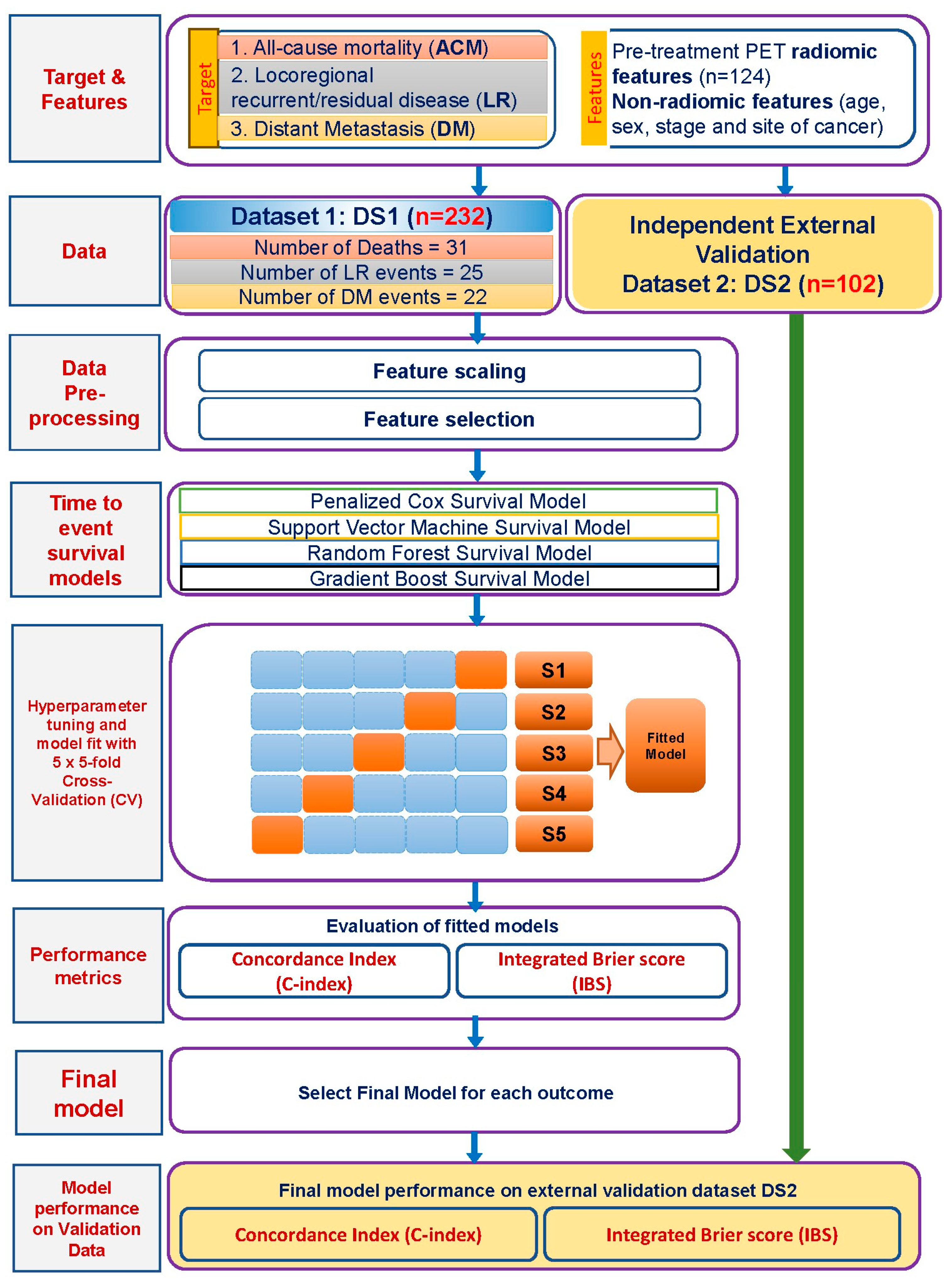

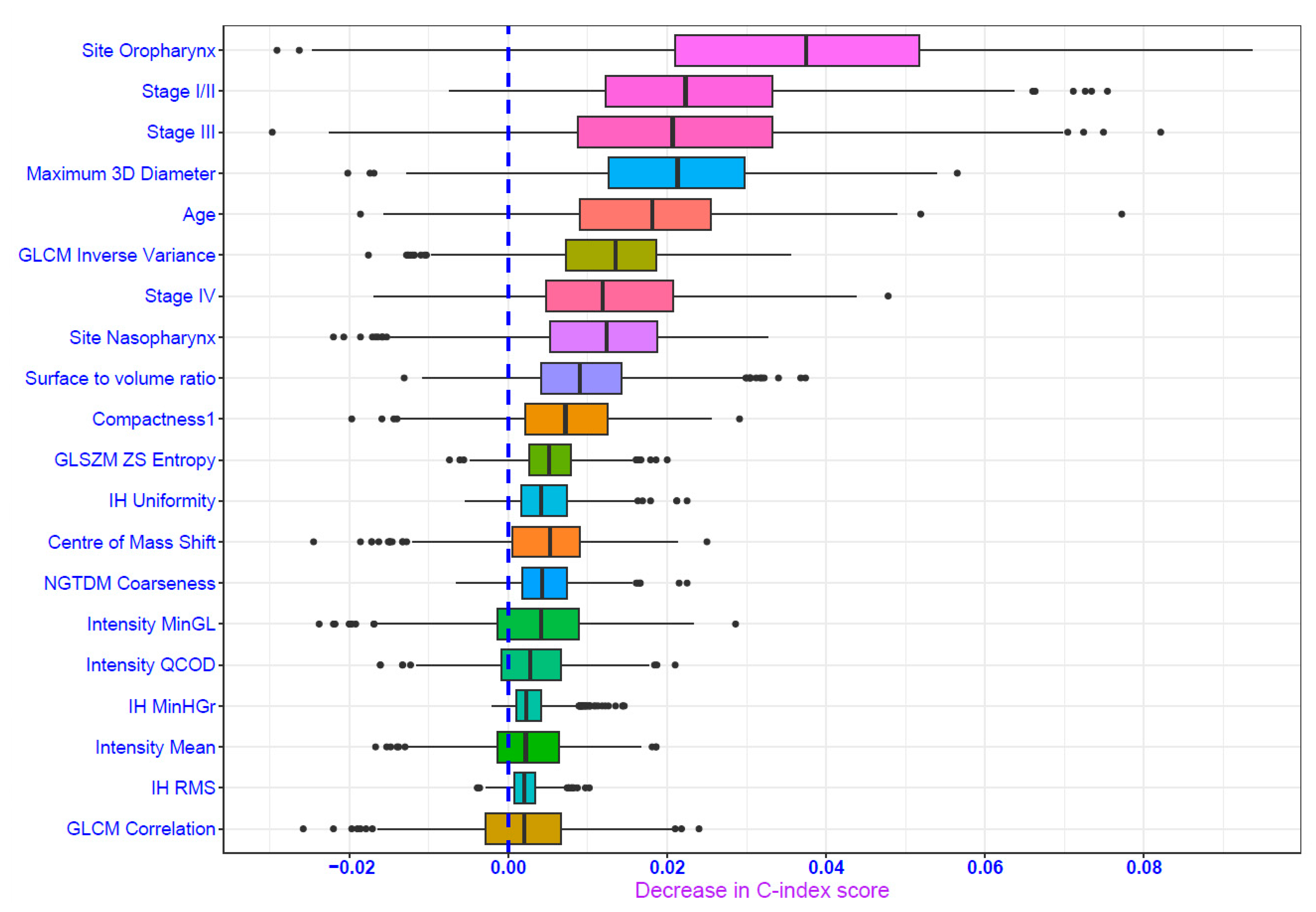

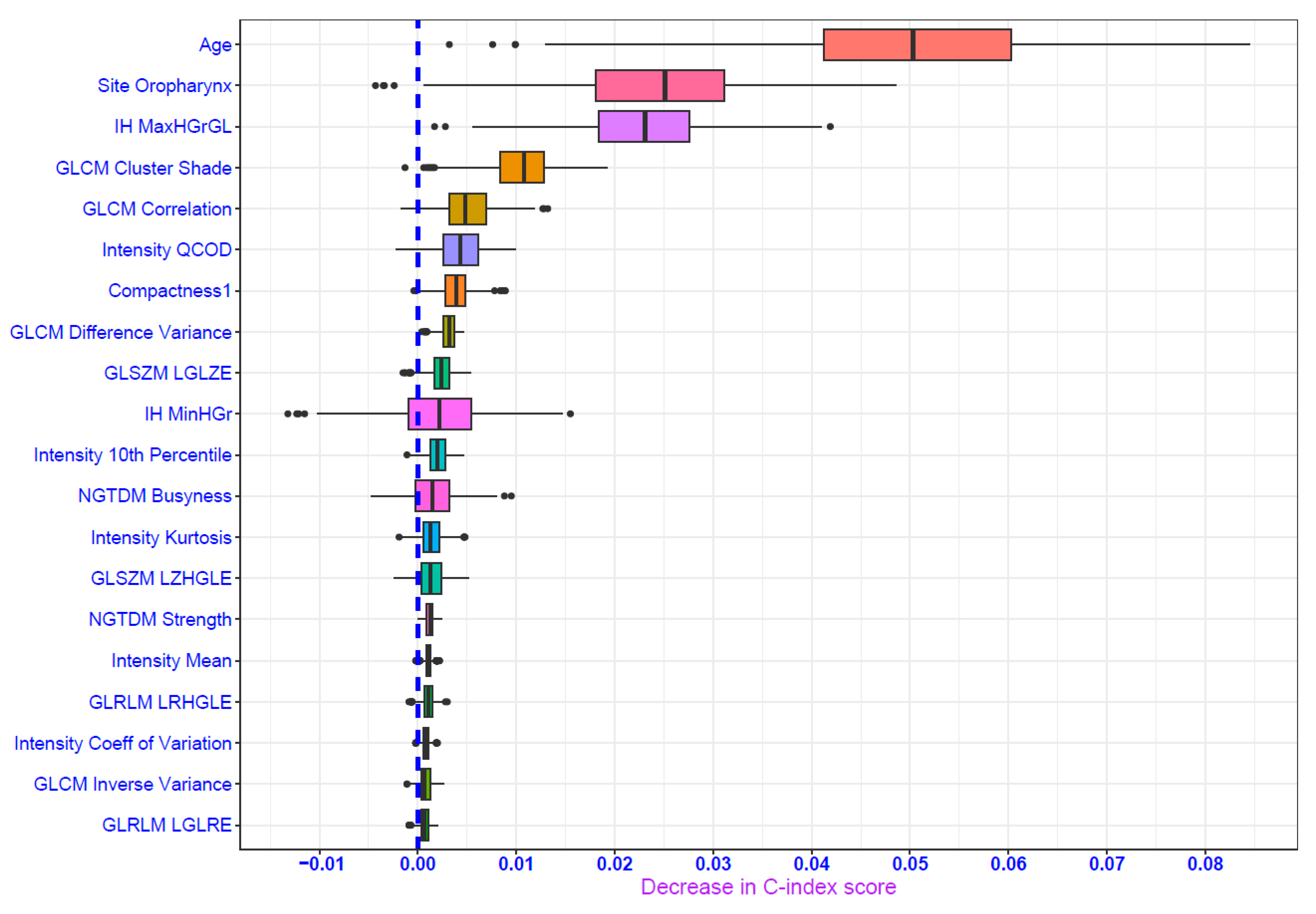
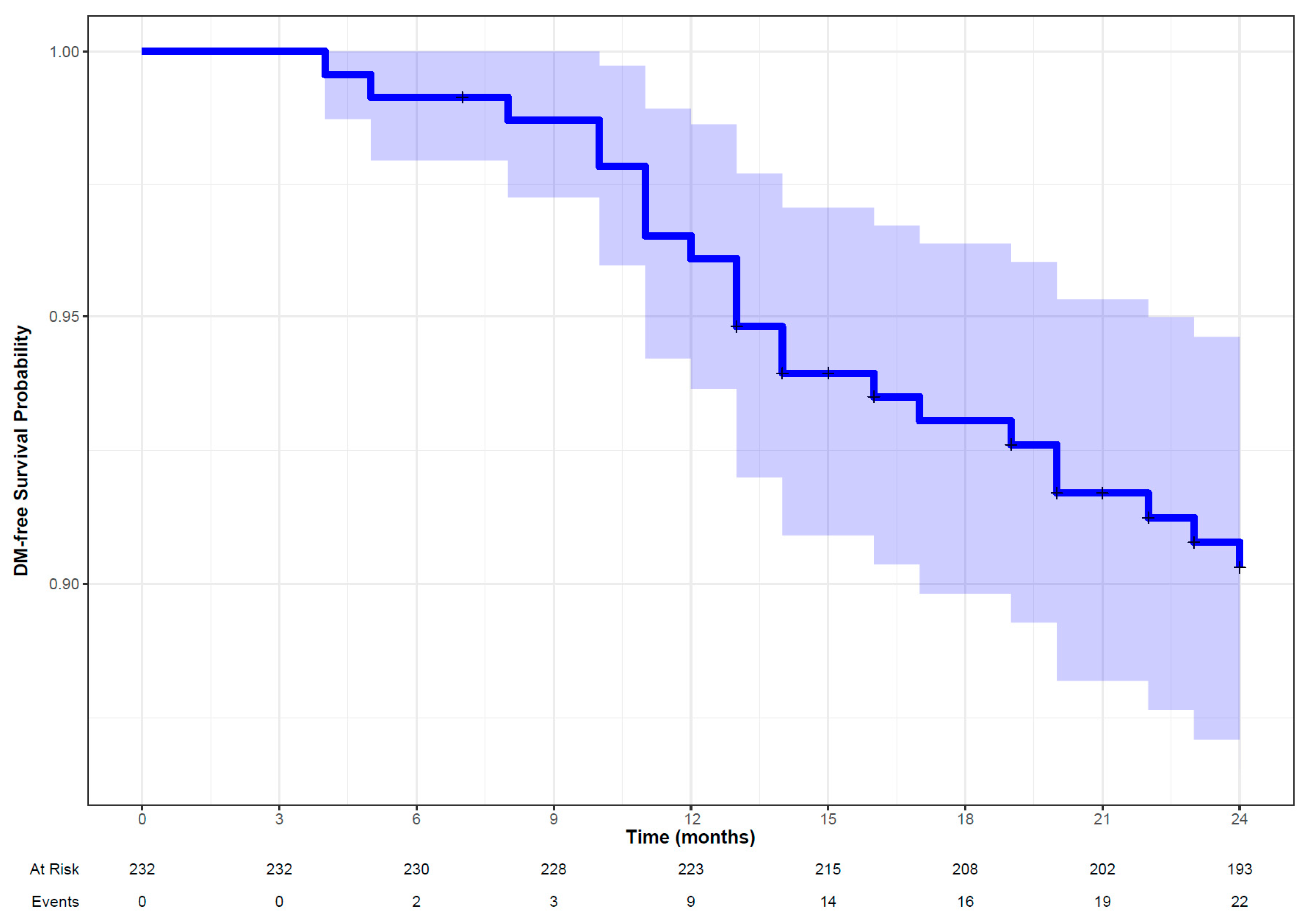
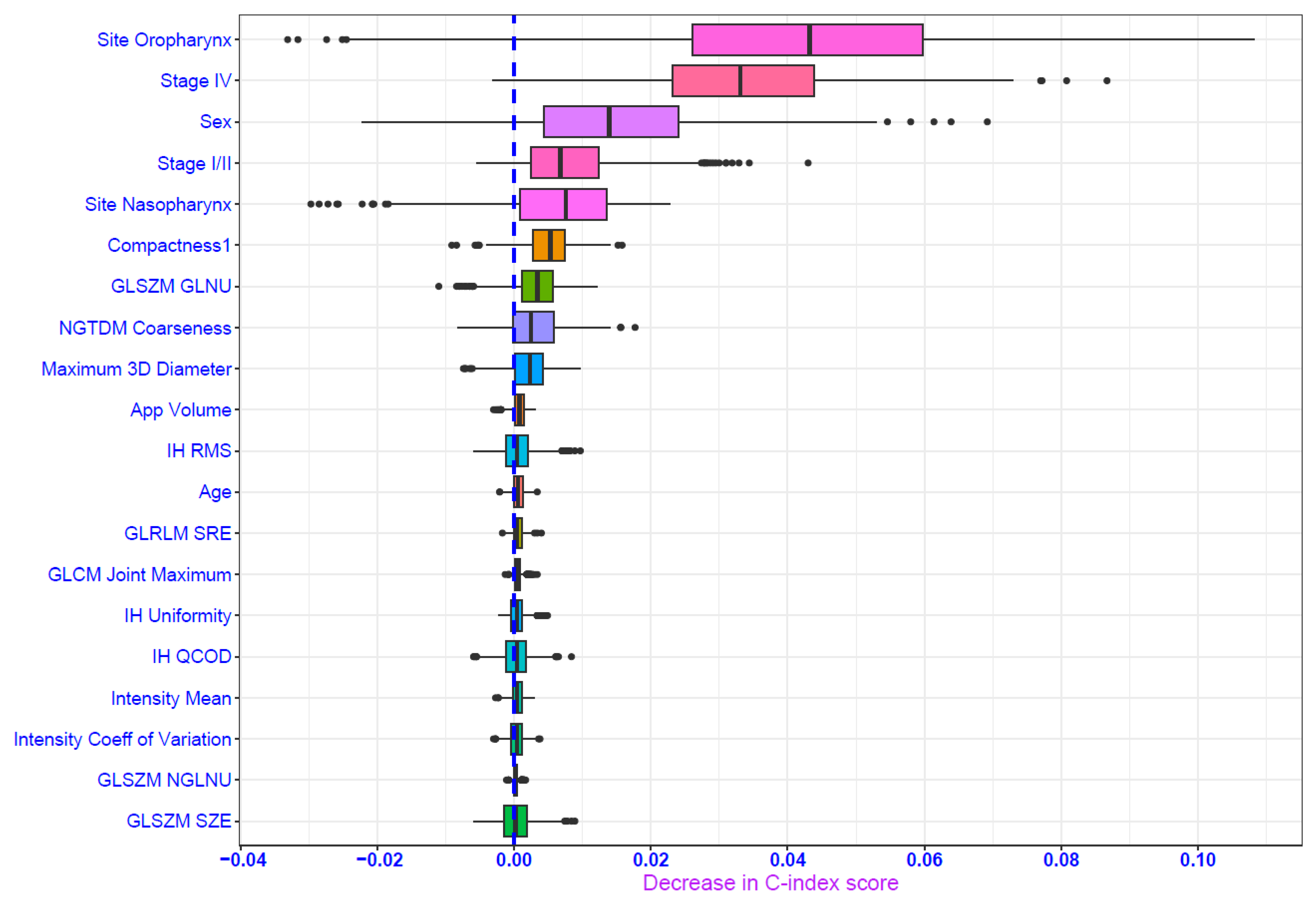
| Variable | Summary | Estimate (Dataset 1) | Estimate (Dataset 2) |
|---|---|---|---|
| Number of patients | Total | 232 | 102 |
| Sex | Male | 182 | 90 |
| Female | 50 | 12 | |
| Age (years) | Overall: Mean (SD) | 63.03 (10.38) | 58.18 (8.96) |
| Primary site [n (%)] | Oropharynx | 166 (71.55) | 75 (73.53) |
| Nasopharynx | 22 (9.48) | 4 (3.92) | |
| Hypopharynx | 8 (3.44) | 6 (5.88) | |
| Others (Larynx, Glottis, Oral cavity, Sinus) | 36 (15.52) | 17 (16.67) | |
| Stage of cancer [n (%)] | Stage I/II (II, IIB) | 24 (10.34) | 4 (3.92) |
| Stage III | 55 (23.71) | 16 (15.69) | |
| Stage IV (IV, IVA, IVB) | 153 (65.95) | 82 (80.39) | |
| Treatment strategy [n (%)] | Chemoradiation with/without surgery | 196 (84.48) | 57 (55.88) |
| Chemoradiation with/without surgery and targeted therapy | - | 7 (6.86) | |
| Radiation with/without surgery | 36 (15.52) | 25 (24.51) | |
| Radiation with/without surgery and targeted therapy | - | 13 (12.75) | |
| Number [n (%)] | All-cause deaths | 31 (13.36) | 21 (20.59) |
| Locoregional recurrent/residual disease | 25 (10.78) | 14 (13.73) | |
| Distant metastasis | 22 (9.48) | 12 (11.76) | |
| Follow-up time in months [Median (Interquartile range)] | All-cause mortality (ACM) | 41 (25.96) | 63 (48.99) |
| Locoregional recurrent/residual disease (LR) | 38 (26.38) | 53 (60.31) | |
| Distant metastasis (DM) | 39 (27.43) | 53 (60.31) |
| Outcome of Interest | Model | Concordance Index (CI) | Integrated Brier Score (IBS) | ||
|---|---|---|---|---|---|
| Internal Validation (Dataset 1) | External Validation (Dataset 2) | Internal Validation (Dataset 1) | External Validation (Dataset 2) | ||
| All-cause mortality (ACM) | Penalized Cox | 0.78 | 0.70 | 0.05 | 0.12 |
| Random forest | 0.72 | 0.70 | 0.05 | 0.12 | |
| Gradient boosted model | 0.78 | 0.66 | 0.06 | 0.12 | |
| Support vector machine | 0.81 | 0.70 | NA | NA | |
| Locoregional recurrent/residual disease (LR) | Penalized Cox | 0.84 | 0.66 | 0.05 | 0.07 |
| Random forest | 0.86 | 0.76 | 0.05 | 0.07 | |
| Gradient boosted model | 0.79 | 0.61 | 0.06 | 0.07 | |
| Support vector machine | 0.82 | 0.65 | NA | NA | |
| Distant metastasis (DM) | Penalized Cox | 0.79 | 0.70 | 0.04 | 0.08 |
| Random forest | 0.76 | 0.70 | 0.04 | 0.08 | |
| Gradient boosted model | 0.79 | 0.71 | 0.04 | 0.09 | |
| Support vector machine | 0.77 | 0.71 | NA | NA | |
Disclaimer/Publisher’s Note: The statements, opinions and data contained in all publications are solely those of the individual author(s) and contributor(s) and not of MDPI and/or the editor(s). MDPI and/or the editor(s) disclaim responsibility for any injury to people or property resulting from any ideas, methods, instructions or products referred to in the content. |
© 2024 by the authors. Licensee MDPI, Basel, Switzerland. This article is an open access article distributed under the terms and conditions of the Creative Commons Attribution (CC BY) license (https://creativecommons.org/licenses/by/4.0/).
Share and Cite
Philip, M.M.; Watts, J.; McKiddie, F.; Welch, A.; Nath, M. Development and Validation of Prognostic Models Using Radiomic Features from Pre-Treatment Positron Emission Tomography (PET) Images in Head and Neck Squamous Cell Carcinoma (HNSCC) Patients. Cancers 2024, 16, 2195. https://doi.org/10.3390/cancers16122195
Philip MM, Watts J, McKiddie F, Welch A, Nath M. Development and Validation of Prognostic Models Using Radiomic Features from Pre-Treatment Positron Emission Tomography (PET) Images in Head and Neck Squamous Cell Carcinoma (HNSCC) Patients. Cancers. 2024; 16(12):2195. https://doi.org/10.3390/cancers16122195
Chicago/Turabian StylePhilip, Mahima Merin, Jessica Watts, Fergus McKiddie, Andy Welch, and Mintu Nath. 2024. "Development and Validation of Prognostic Models Using Radiomic Features from Pre-Treatment Positron Emission Tomography (PET) Images in Head and Neck Squamous Cell Carcinoma (HNSCC) Patients" Cancers 16, no. 12: 2195. https://doi.org/10.3390/cancers16122195
APA StylePhilip, M. M., Watts, J., McKiddie, F., Welch, A., & Nath, M. (2024). Development and Validation of Prognostic Models Using Radiomic Features from Pre-Treatment Positron Emission Tomography (PET) Images in Head and Neck Squamous Cell Carcinoma (HNSCC) Patients. Cancers, 16(12), 2195. https://doi.org/10.3390/cancers16122195









